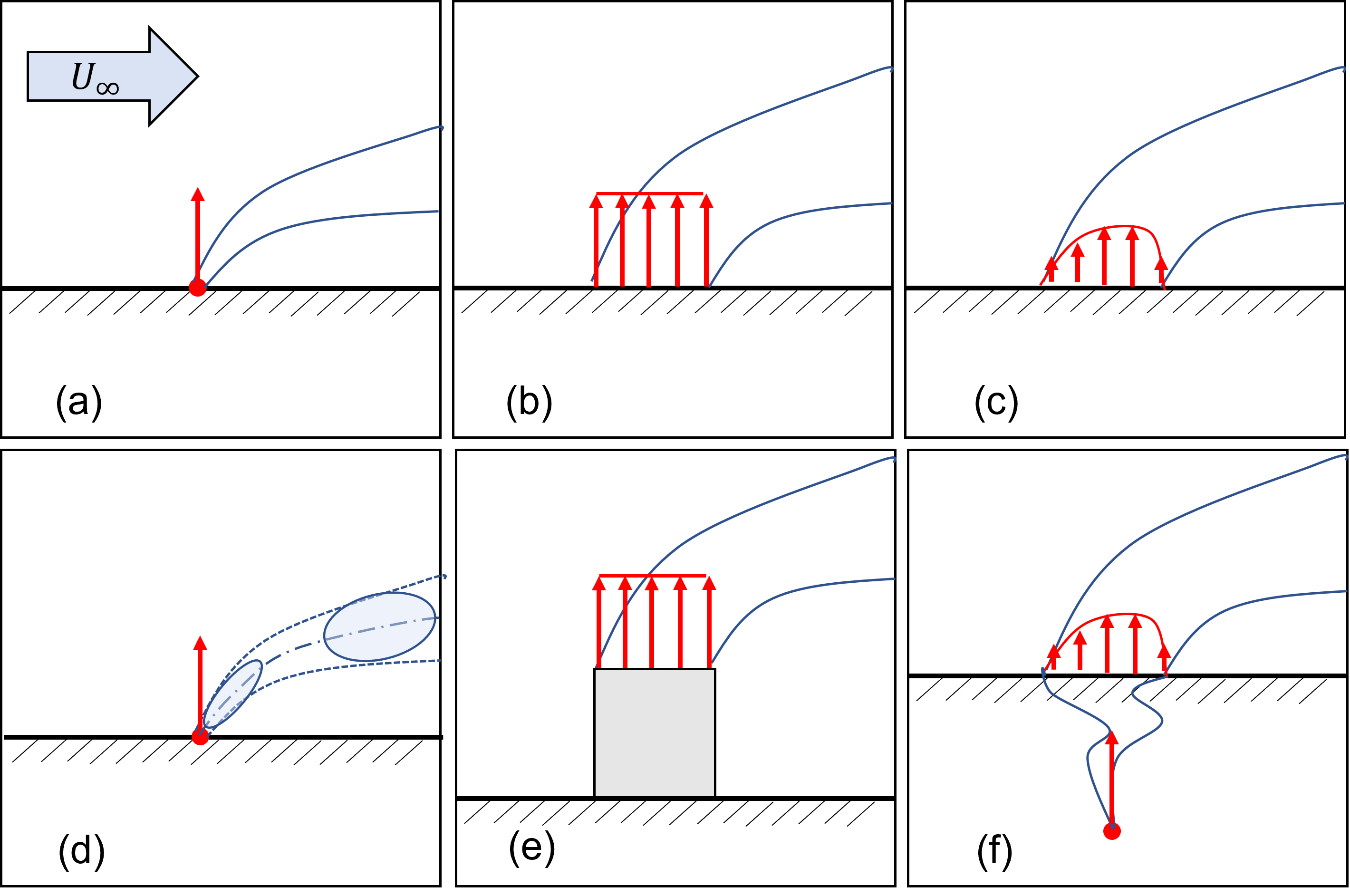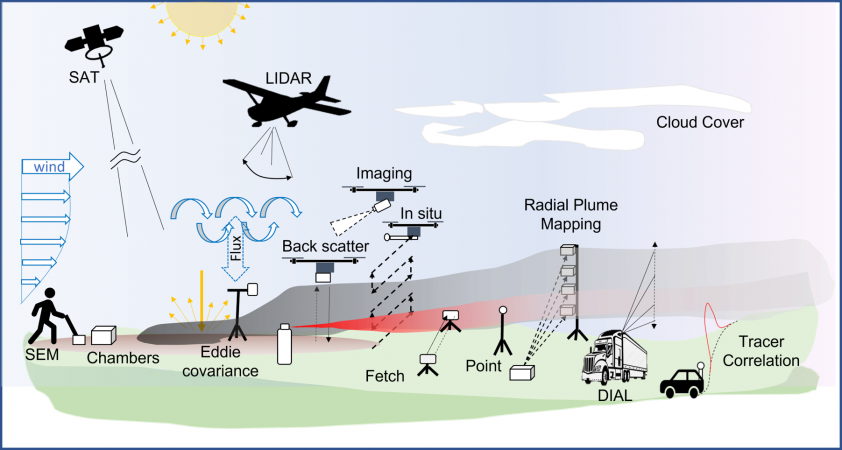Mission Statement:
The Center for Methane Emission Research and Innovation (CMERI) at UC Merced takes closed-loop thinking (sensing/actuation, see Fig.1) for taking climate actions against methane emissions due to both environmental and anthropogenic emissions. CMERI aims to develop actionable information from methane emission sensing and quantification for emission reduction and mitigation actions, and to contribute to education, outreach and workforce development for disadvantaged communities.

Fig. 1: Conceptual closed loop model representing the feedback for reducing methane emissions.
Current Tasks:
CMERI has broadly broken the current tasks into two main categories, sensing/measurement and mitigation/reduction. Following the feedback structure of Fig.1, the following tasks listed below will reflect the closed loop diagram shown in Fig. 2, which will help us inform and assess the research to be made.
Fig 2: CMERI’s closed-loop thinking in methane emission sensing and mitigation actions (M/V measurement and verification: a foundation for incentive policy design before and after methane reduction/mitigation actions taken.
1. Investigate biogas mitigation options for methane reduction (PI Kurtz)
This task is to study the current practices and future development recommendations for biogas production and usage for methane emission reduction in dairy farm industries in California Central Valley. Based on the first biogas workshop hosted by CITRIS UC Merced led by PI Kurtz in Nov. 2019 [1].
- Survey methane mitigation via biogas production technologies;
- Decide methane reduction quantification method;
- Study biogas end use and economic impact in dairy farm setting;
- Research on automation and optimal process control for biogas production;
2. To develop biochar production and investigate its use in reducing dairy farm manure management emissions (PI Diaz)
This task heavily leverages the previous work by PI Diaz's $3M project grant from California’s Strategic Growth Council (SGC) titled, “Mobile Biochar Production For Methane Emission Reduction And Soil Amendment”, which, will ends in March 2023. Subsequent work in Task 2 along the roadmap similar to the SGC project includes
- Biomass gasification unit on site dairy farm for selected biomass feedstocks. In general, biomass feedstocks include dedicated energy crops, agricultural crop residues, forestry residues, algae, wood processing residues, municipal waste, and wet waste (crop wastes, forest residues, purpose-grown grasses, woody energy crops, algae, industrial wastes, sorted municipal solid waste [MSW], urban wood waste, and food waste). We will study what are the best options for biomass feedstock and the corresponding best gasification method.
- Best practice in manure composting. In 2016, agriculture generated around 8% of emissions in California, 34% from manure management. Dairy farms are the single largest contributor to California’s man-made methane production. The addition of biochar to manure composting reduces emissions from manure management by 27% to 32%. This means that a successful biochar practice has the potential to reduce methane emissions from manure management by at least 2.74 MMT CO2 per year.
- Using methane emission measurement to iteratively optimize the overall workflow for biochar production and its use in dairy farm manure management.
3. To develop methane sensing ground-truthing efforts and control tests for validating methane quantification strategies (PI Chen and Zhang)
This task aims to address the ground-truthing of methane gas: (1) from various controlled release sources (point, area, and multi-point) using existing UC Merced resources, such as, the Vernal Pools and Grassland Reserve (MVPGR), and the Smart Farm for validating detection/quantification methodologies using big
data machine learning and Digital Twins; (2) from biochar soil amendments to laboratory and field tests, such as with surface chambers; and (3) locally measured and mapped background methane from low cost spatially distributed IoT sensors.
4. To develop smart methane quantification strategies utilizing machine learning based big data and digital twins (PI Chen)
This task aims to develop and improve on sUAS-based methane sensing and quantification strategies [2,3,4] by exploring various source types (point, area, and multi-source, see Fig. 3), sensor capabilities (in situ, and imaging), as well as environmental conditions. To do this we plan to explore new and existing sUAS-based advanced leak detection and quantification methods (LDAQ), such as those outlined in [2] (some concepts shown in Fig. 4) with Digital Twin (DT) frameworks [5] (an example DT is shown in Fig. 5), which will represent the plume as well as the sites infrastructure (e.g. digital smart farm).

Fig 3: Examples of different source types, where the red signifies the source.

Fig 4: Diagram depicting advanced leak detection and quantification (LDAQ) modalities.

Fig 5: (left) The digital twin framework for environmental monitoring of a gas plume (right) the localization and quantification of a controlled release of methane at APRA-E’s METEC site. The bottom simulation depicts the digital twin of METEC [3].
California Climate Adaptiation Priorities (Alignment with California Priorities):
- Strengthen Protections for Climate Vulnerable Communities
- Bolster Public Health and Safety to Protect Against Increasing Climate Risks
- Build a Climate Resilient Economy
- Accelerate Nature-Based Climate Solutions and Strengthen Climate Resilience of Natural Systems
- Make Decisions Based on the Best Available Climate Science
- Partner and Collaborate to Leverage Resources
References
- (2019, November 12). Workshop: What Should We Do with Biogas? | Register by Nov 1st. UC Merced. Retrieved February 22, 2022, from https://engineering.ucmerced.edu/events/workshop-what-should-we-do-bioga...
- Hollenbeck, D., Zulevic, D., & Chen, Y. (2021). Advanced leak detection and quantification of methane emissions using suas. Drones, 5(4), 117.
- Hollenbeck, D., Zulevic, D., & Chen, Y. (2022, June). A modified near-field gaussian plume inversion method using multi-sUAS for emission quantification. In 2022 International Conference on Unmanned Aircraft Systems (ICUAS) (pp. 1620-1625). IEEE.
- Hollenbeck, D., Zulevicl, D., & Chen, Y. (2022, November). Single and Multi-sUAS Based Emission Quantification Performance Assessment Using MOABS/DT: A Simulation Case Study. In 2022 18th IEEE/ASME International Conference on Mechatronic and Embedded Systems and Applications (MESA) (pp. 1-5). IEEE.
- Hollenbeck, D., & Chen, Y. (2020, September). Characterization of ground-to-air emissions with sUAS using a digital twin framework. In 2020 International Conference on Unmanned Aircraft Systems (ICUAS) (pp. 1162-1166). IEEE.


